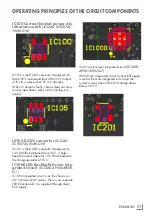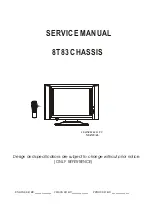
85
ENGLISH
FAILURE/ERROR ANALYSES
-------------------------------------------------------------
Sound available but no picture, and back-lights illuminated
In this section, we will basically explain where
we need to check if there is "no picture on TV"
even though there are not any problems in
the panel inverter. Here, we are assuming that
chassis is generally in good condition as we
obtain sound output from TV. When you cannot
determine if the back-light is working or not due
to the illumination level in the environment, you
are recommended to tap on the TV's front panel
lightly; if the back-light is working, you will no-
tice a slight glowing.
Before starting controls and repairs, it is cru-
cial to analyze and comprehend the problem
exactly. In this problem, you must make sure if
it is originated from the utilized source, if it is
a cable connection error or if utilized devices
have any problems or not.
Then, particularly LVDS cable on the chassis
should be checked for any disconnections,
loose parts, dislocations, breaks or ruptures.
Likewise, it will be proper to check cable con-
nections of the panel.
Later, the panel power (PANEL-PWR) supplied
to the panel T-CON board over LVDS cable
should be checked on T100 in the chassis. Panel
supply for the products with GM chassis is 12V.
If this supply is unavailable, whether 12V feed-
ing is present on S100 socket will be checked
from pin #4 or 5. If 12V supply is not found on
S100 socket although POWER_SW signal ex-
ists, PSU should be replaced. If POWER_SW
signal is not available, main IC and peripheral
components should be checked.
If VCC_PANEL voltage is found in T100 Leg 2
but not found in Leg 3; peripheral components
will be checked. When TV is "ON", a voltage
around 3.8V occurs on Leg 1 of FET as to be
higher than 0V, and supply voltage on Leg 2 is
transferred to Leg 3. Check "TCON_ON" sig-
nal, Leg 1 of R125 resistance. Here, if the volt-
age is High, it means that panel supply has not
been turned on from the main integrated circuit
or software. This signal remains high while the
TV is going out of Stand-By and gets down to
0V, 1 seconds before the picture appears on the
screen.
If the panel is supplied voltage over LVDS, it is
most likely that picture information is transmitted
as well. Even if we do not have any precise con-
trol method for information flow over data lines,
the voltage is around 1.2V DC as detected by
means of a measuring tool. If this voltage cannot
be received, main processor might be faulty.
If LVDS data leaves Main Processor without
problems, problem might be in panel.
Besides, you can also consider problems includ-
ing that LVDS data is not being transmitted to the
panel properly, i.e. panel parameters are wrong
in NAND Flash or software installation error.
Problem can be eliminated by installing the ap-
propriate software.
Summary of Contents for COREMAX M1 PROJECT GM
Page 1: ...COREMAX M1 PROJECT GM CHASSIS SERVICE MANUAL...
Page 66: ...ENGLISH 66 GENERAL OPERATING PRINCIPLE OF THE TV Block Diagram...
Page 81: ...ENGLISH 81 CHASSIS DIAGRAMMATIC IMAGES Chassis DC Socket DC voltages...
Page 82: ...ENGLISH 82 CHASSIS DIAGRAMMATIC IMAGES...
Page 83: ...ENGLISH 83 CHASSIS DIAGRAMMATIC IMAGES Terrestrial tuner Satellite tuner...
Page 84: ...ENGLISH 84 CHASSIS DIAGRAMMATIC IMAGES USB...
Page 86: ...ENGLISH 86 FAILURE ERROR ANALYSES...
Page 88: ...ENGLISH 88 FAILURE ERROR ANALYSES...



































